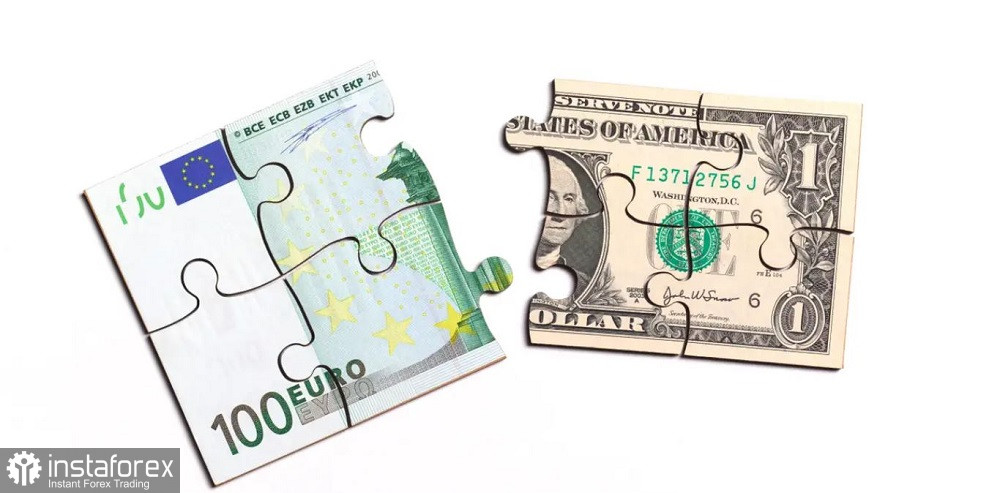The bears of the EUR/USD pair have consolidated within the confines of the 7th figure but have not ventured further. The support level at 1.0710 (lower Bollinger Bands line on the 4-hour chart) held its ground, while breaching it would pave the way for the price to reach the main barrier at 1.0620 (middle Bollinger Bands line on the monthly timeframe). Traders are taking a break, although the bearish sentiments persist.

The US Dollar Index returned to the 104-figure range this week, marking a nearly 3-month high and reflecting higher demand for the US currency. On the other hand, the euro is under pressure due to the European Central Bank's dovish sentiments, whose representatives noticeably softened their rhetoric. In such conditions, any pullback of a fundamental nature should be interpreted as an opportunity to open short positions. There are too many arguments in favor of the downward scenario and too few in favor of a trend reversal.
Take a look at the EUR/USD weekly chart: the pair has consistently fallen for the fourth consecutive week, although we have observed a downtrend since mid-December. In early January, buyers tried to stage a comeback and came close to realizing it: the price returned to the 10-figure range, reflecting the euro's strength. But alas – much to the buyers' disappointment, subsequent events put an end to their bullish ambitions.
In general, the Federal Reserve and the ECB have swapped places in terms of their communicated rhetoric. At the end of last year, Fed Chair Jerome Powell surprised market participants with his dovish statements – effectively announcing a rate cut at one of the upcoming meetings. Following Powell, a surprising statement was made by a consistent hawk, Christopher Waller, a member of the Federal Reserve Board. He also allowed for a rate cut in case inflation slows down.
In turn, the ECB took the opposite position at that time. The central bank reassured market participants that interest rates would remain at the current level at least until the summer. Some ECB members (such as the head of the Austrian central bank, Holzmann) even suggested maintaining the status quo until the end of 2024.
Such information has supported the buyers in late December, as they pushed the price to the level of 1.1140.
However, the situation significantly changed in January. As mentioned above, the ECB and the Fed have reversed their rhetoric: the Fed expressed doubts about lowering the interest rate in the near future, while ECB officials started to escalate the situation.
In particular, the head of the Bank of Spain, Pablo Hernandez de Cos, said on Tuesday that inflation is returning to the target level, and therefore the next step for the ECB will be a rate cut. ECB official Mario Centeno voiced a similar position. According to him, if inflation continues to move along the expected trajectory, the ECB's next decision will be to lower interest rates. ECB Chief Economist Philip Lane refrained from rate forecasts but also said that the problems associated with the situation in the Red Sea are quite contained, given the small contribution of transportation costs to inflation. In other words, he played down the assumptions of some experts that events in the Middle East will affect inflation dynamics in the eurozone.
By the way, the ECB just published its monthly report on consumer expectations, according to which inflation expectations in the eurozone continue to decline. Consumer inflation expectations for the next 12 months fell in December to 3.2% (November value - 3.5%). This is the lowest reading of the indicator since February 2022. The median level of expected inflation for the previous 12 months was 6.9% (previous value - 7.6%). At the same time, survey participants expect economic growth to fall (by 1.3%) over the next 12 months. The latest eurozone inflation data (for January) turned out to be in the "green," but at the same time reflected a slowdown in both the overall and core CPI. Thus, the Consumer Price Index reached 2.8% against a forecast of 2.7%. The core CPI, instead of the predicted decrease to 3.2%, decreased to 3.3%.
According to ECB President Christine Lagarde, and Klaas Knot (head of the Dutch central bank), the ECB will start lowering interest rates once they are confident that wage growth adapts to lower inflation. "The only piece that's missing is the conviction that wage growth will adapt to that lower inflation," Knot said.
Meanwhile, the US central bank continues to erase hopes of aggressive rate cuts. Strong US GDP growth in the fourth quarter, robust non-farm payrolls, an increase in overall inflation, and average wage levels, as well as geopolitical tensions – all these factors indicate that the Fed will not rush to ease monetary policy. According to currency strategists at Bank of America, the first rate cut will take place at the June meeting (previously they guided their clients to March, but after the Fed's January meeting, BOA experts updated their forecast).
However, if US inflation continues to accelerate, and the labor market heats up further, the date of the first rate cut may need to be postponed again – to July or September.
In my opinion, the fundamental background will support the downward movement in the medium term. The first target is 1.0710 (lower line of the Bollinger Bands indicator on the 4-hour chart). The main target is 1.0620 (middle line of the Bollinger Bands indicator on the MN timeframe).





















